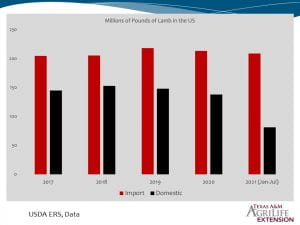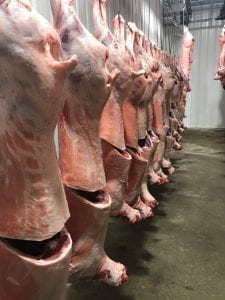Dr. Reid Redden, Associate Professor and Extension Sheep and Goat Specialist, Texas A&M AgriLife Extension Service
(Reid’s Ram-blings: November 2021)
By now  you know that I am a strong proponent of eating and promoting the consumption of lamb and goat meat. Bottom line, it is delicious, but the reasons to include lamb or goat in your meal rotation do not end there. It is nutritious and versatile in the ways it can be prepared. And as producers I believe it is important for us to be advocates of our own products.
you know that I am a strong proponent of eating and promoting the consumption of lamb and goat meat. Bottom line, it is delicious, but the reasons to include lamb or goat in your meal rotation do not end there. It is nutritious and versatile in the ways it can be prepared. And as producers I believe it is important for us to be advocates of our own products.
When we cook and eat lamb and goat ourselves, we also become better advocates for it. I can’t count the number of times, I’ve heard “I only like lamb when Reid cooks it.” Over time, the fear of something different and we gain another advocate. Be Patient!
As a routine customer, I’m always inquiring about the origin of the product. Often, they are sourced from another country. Imported lamb is perceived by many consumers as Continue reading Small Ruminant Imports: Friend or Foe?

 is a continuing trend among animal product consumers – they want sustainably and humanely raised meat, milk, and eggs. Generation Z is the driving force behind consumers wanting to know exactly where their food comes from and the values behind the farming operation. With this trend, many cattle, hog, and sheep producers are selling animals to customers and sending the purchased animals off for custom processing. Other producers may be choosing to sell retail cuts in a roadside shop or farmers markets. If selling lamb directly off the farm is something your operation is currently doing or has discussed as a future enterprise, turning a profit on sales should be somewhere in the back of your mind.
is a continuing trend among animal product consumers – they want sustainably and humanely raised meat, milk, and eggs. Generation Z is the driving force behind consumers wanting to know exactly where their food comes from and the values behind the farming operation. With this trend, many cattle, hog, and sheep producers are selling animals to customers and sending the purchased animals off for custom processing. Other producers may be choosing to sell retail cuts in a roadside shop or farmers markets. If selling lamb directly off the farm is something your operation is currently doing or has discussed as a future enterprise, turning a profit on sales should be somewhere in the back of your mind.
